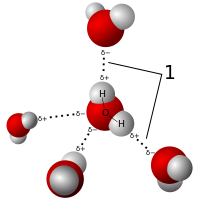
Photo from wikipedia
Abstract Dimeric acylphloroglucinols (D-ACPLs) are a large subclass of acylphloroglucinols. Their molecules contain two acylphloroglucinol units connected by a methylene bridge. They often exhibit enhanced biological activity with respect to… Click to show full abstract
Abstract Dimeric acylphloroglucinols (D-ACPLs) are a large subclass of acylphloroglucinols. Their molecules contain two acylphloroglucinol units connected by a methylene bridge. They often exhibit enhanced biological activity with respect to monomeric acylphloroglucinols. Within each unit, an intramolecular hydrogen bond (IHB) forms between the sp 2 O of the acyl group and a neighbouring phenol OH. With the exception of few very high energy conformers, the two units are also connected by two IHBs, one on each side of the methylene bridge, resulting in the presence of four IHBs in each conformer. At least some of the IHBs engage different donors or acceptors in different conformers, engendering different IHB patterns, which characterise different conformers and are largely responsible for their molecular properties. The current work presents the results of a computational study of an adequately representative selection of D-ACPLs, with major focus on IHB patterns and how they determine conformational preferences and influence the other molecular properties. The characteristics of the IHBs in each conformer-type are analysed in detail. Comparisons of the considered properties across the calculated structures enable the identification of patterns that can be expected to extend to the entire D-ACPL subclass, enabling reasonable predictions for other D-ACPL molecules.
Journal Title: Journal of Molecular Structure
Year Published: 2019
Link to full text (if available)
Share on Social Media: Sign Up to like & get
recommendations!